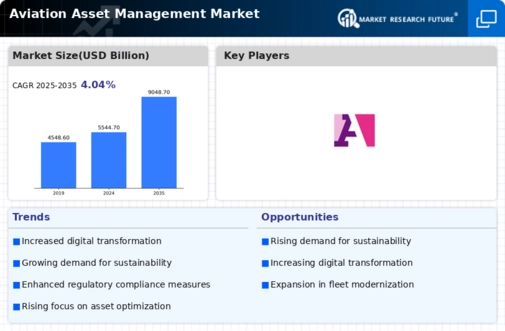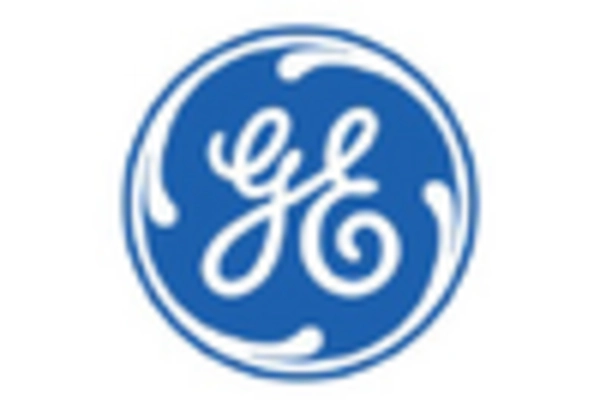-
Executive Summary
-
Market Attractiveness Analysis
- Global Aviation Asset Management Market, by Service Type
- Global Aviation Asset Management Market, by End Use
- Global Aviation Asset Management Market, by Region
-
Market Introduction
-
Market Definition
-
Scope of the Study
-
Market Structure
-
Key Buying Criteria
-
Market Factor Indicator Analysis
-
Research Methodology
-
Research Process
-
Primary Research
-
Secondary Research
-
Market Size Estimation
-
Forecast Model
-
List of Assumptions
-
Market Insights
-
Market Dynamics
-
Introduction
-
Drivers
- Increase in Air Passenger Traffic
- Development of New Aircraft Models
- Drivers Impact Analysis
-
Restraints
- Stringent Industry Regulations
- Restraints Impact Analysis
-
Opportunities
- Green Initiatives by the Aviation Industry
- Increasing Number of Low-Cost Carriers
-
Market/Technological Trends
-
Patent Trends
-
Regulatory Landscape/Standards
-
Market Factor Analysis
-
Supply Chain Analysis
- R&D
- Manufacturing
- Distribution & Sales
- Post-Sales Monitoring
-
Porter’s Five Forces Analysis
- Threat of New Entrants
- Bargaining Power of Buyers
- Bargaining Power of Suppliers
- Threat of Substitutes
- Intensity of Rivalry
-
Global Aviation Asset Management Market, by Service Type
-
Introduction
-
Leasing Services
-
Technical Services
-
Regulatory Certification
-
Global Aviation Asset Management Market, by End Use
-
Introduction
-
Commercial Platforms
-
Maintenance, Repair, and Overhaul (MRO) Services
-
Global Aviation Asset Management Market, by Region
-
Introduction
-
North America
- US
- Canada
-
Europe
- UK
- Germany
- France
- Spain
- Russia
- Rest of Europe
-
Asia-Pacific
- China
- India
- Japan
- Australia
- Rest of Asia-Pacific
-
Middle East & Africa
- Saudi Arabia
- UAE
- Rest of the Middle East & Africa
-
Latin America
- Brazil
- Rest of Latin America
-
Competitive Landscape
-
Competitive Overview
-
Competitor Dashboard
-
Major Growth Strategies in the Global Aviation Asset Management Market
-
Competitive Benchmarking
-
Market Share Analysis
-
Leading Player in Terms of Number of Developments in the Global Aviation Asset Management Market
-
Key Developments & Growth Strategies
- Product Launches/Service Deployments
- Mergers & Acquisitions
- Joint Ventures
-
Company Profiles
-
Key Market Players
- AerData BV
- Airbus SAS
- Aercap Holdings NV
- GE Capital Aviation Services
- Charles Taylor Aviation (Asset Management) Ltd
- BBAM Aircraft Leasing & Management
- Aviation Asset Management, Inc.
- Skyworks Capital, LLC
- GA Telesis, LLC
- Acumen
-
(Company overview, products & services offered, financial overview, key developments, SWOT analysis, and key strategies to be covered for public companies)
-
Appendix
-
References
-
Related Reports
-
List of Abbreviations
-
-
List of Tables
-
LIST OF ASSUMPTIONS
-
GLOBAL AVIATION ASSET MANAGEMENT MARKET, BY SERVICE TYPE, 2020-2030 (USD MILLION)
-
GLOBAL AVIATION ASSET MANAGEMENT MARKET, BY END USE, 2020-2030 (USD MILLION)
-
GLOBAL AVIATION ASSET MANAGEMENT MARKET, BY REGION, 2020-2030 (USD MILLION)
-
NORTH AMERICA: AVIATION ASSET MANAGEMENT MARKET, BY COUNTRY, 2020-2030 (USD MILLION)
-
NORTH AMERICA: AVIATION ASSET MANAGEMENT MARKET, BY SERVICE TYPE, 2020-2030 (USD MILLION)
-
NORTH AMERICA: AVIATION ASSET MANAGEMENT MARKET, BY END USE, 2020-2030 (USD MILLION)
-
US: AVIATION ASSET MANAGEMENT MARKET, BY SERVICE TYPE, 2020-2030 (USD MILLION)
-
US: AVIATION ASSET MANAGEMENT MARKET, BY END USE, 2020-2030 (USD MILLION)
-
CANADA: AVIATION ASSET MANAGEMENT MARKET, BY SERVICE TYPE, 2020-2030 (USD MILLION)
-
CANADA: AVIATION ASSET MANAGEMENT MARKET, BY END USE, 2020-2030 (USD MILLION)
-
EUROPE: AVIATION ASSET MANAGEMENT MARKET, BY COUNTRY, 2020-2030 (USD MILLION)
-
EUROPE: AVIATION ASSET MANAGEMENT MARKET, BY SERVICE TYPE, 2020-2030 (USD MILLION)
-
EUROPE: AVIATION ASSET MANAGEMENT MARKET, BY END USE, 2020-2030 (USD MILLION)
-
UK: AVIATION ASSET MANAGEMENT MARKET, BY SERVICE TYPE, 2020-2030 (USD MILLION)
-
UK: AVIATION ASSET MANAGEMENT MARKET, BY END USE, 2020-2030 (USD MILLION)
-
GERMANY: AVIATION ASSET MANAGEMENT MARKET, BY SERVICE TYPE, 2020-2030 (USD MILLION)
-
GERMANY: AVIATION ASSET MANAGEMENT MARKET, BY END USE, 2020-2030 (USD MILLION)
-
FRANCE: AVIATION ASSET MANAGEMENT MARKET, BY SERVICE TYPE, 2020-2030 (USD MILLION)
-
FRANCE: AVIATION ASSET MANAGEMENT MARKET, BY END USE, 2020-2030 (USD MILLION)
-
SPAIN: AVIATION ASSET MANAGEMENT MARKET, BY SERVICE TYPE, 2020-2030 (USD MILLION)
-
SPAIN: AVIATION ASSET MANAGEMENT MARKET, BY END USE, 2020-2030 (USD MILLION)
-
RUSSIA: AVIATION ASSET MANAGEMENT MARKET, BY SERVICE TYPE, 2020-2030 (USD MILLION)
-
RUSSIA: AVIATION ASSET MANAGEMENT MARKET, BY END USE, 2020-2030 (USD MILLION)
-
REST OF EUROPE: AVIATION ASSET MANAGEMENT MARKET, BY SERVICE TYPE, 2020-2030 (USD MILLION)
-
REST OF EUROPE: AVIATION ASSET MANAGEMENT MARKET, BY END USE, 2020-2030 (USD MILLION)
-
ASIA-PACIFIC: AVIATION ASSET MANAGEMENT MARKET, BY COUNTRY, 2020-2030 (USD MILLION)
-
ASIA-PACIFIC: AVIATION ASSET MANAGEMENT MARKET, BY SERVICE TYPE, 2020-2030 (USD MILLION)
-
ASIA-PACIFIC: AVIATION ASSET MANAGEMENT MARKET, BY END USE, 2020-2030 (USD MILLION)
-
CHINA: AVIATION ASSET MANAGEMENT MARKET, BY SERVICE TYPE, 2020-2030 (USD MILLION)
-
CHINA: AVIATION ASSET MANAGEMENT MARKET, BY END USE, 2020-2030 (USD MILLION)
-
INDIA: AVIATION ASSET MANAGEMENT MARKET, BY SERVICE TYPE, 2020-2030 (USD MILLION)
-
INDIA: AVIATION ASSET MANAGEMENT MARKET, BY END USE, 2020-2030 (USD MILLION)
-
JAPAN: AVIATION ASSET MANAGEMENT MARKET, BY SERVICE TYPE, 2020-2030 (USD MILLION)
-
JAPAN: AVIATION ASSET MANAGEMENT MARKET, BY END USE, 2020-2030 (USD MILLION)
-
AUSTRALIA: AVIATION ASSET MANAGEMENT MARKET, BY SERVICE TYPE, 2020-2030 (USD MILLION)
-
AUSTRALIA: AVIATION ASSET MANAGEMENT MARKET, BY END USE, 2020-2030 (USD MILLION)
-
REST OF ASIA-PACIFIC: AVIATION ASSET MANAGEMENT MARKET, BY SERVICE TYPE, 2020-2030 (USD MILLION)
-
REST OF ASIA-PACIFIC: AVIATION ASSET MANAGEMENT MARKET, BY END USE, 2020-2030 (USD MILLION)
-
MIDDLE EAST & AFRICA: AVIATION ASSET MANAGEMENT MARKET, BY COUNTRY, 2020-2030 (USD MILLION)
-
MIDDLE EAST & AFRICA: AVIATION ASSET MANAGEMENT MARKET, BY SERVICE TYPE, 2020-2030 (USD MILLION)
-
MIDDLE EAST & AFRICA: AVIATION ASSET MANAGEMENT MARKET, BY END USE, 2020-2030 (USD MILLION)
-
SAUDI ARABIA: AVIATION ASSET MANAGEMENT MARKET, BY SERVICE TYPE, 2020-2030 (USD MILLION)
-
SAUDI ARABIA: AVIATION ASSET MANAGEMENT MARKET, BY END USE, 2020-2030 (USD MILLION)
-
UAE: AVIATION ASSET MANAGEMENT MARKET, BY SERVICE TYPE, 2020-2030 (USD MILLION)
-
UAE: AVIATION ASSET MANAGEMENT MARKET, BY END USE, 2020-2030 (USD MILLION)
-
REST OF THE MIDDLE EAST & AFRICA: AVIATION ASSET MANAGEMENT MARKET, BY SERVICE TYPE, 2020-2030 (USD MILLION)
-
REST OF THE MIDDLE EAST & AFRICA: AVIATION ASSET MANAGEMENT MARKET, BY END USE, 2020-2030 (USD MILLION)
-
LATIN AMERICA: AVIATION ASSET MANAGEMENT MARKET, BY COUNTRY, 2020-2030 (USD MILLION)
-
LATIN AMERICA: AVIATION ASSET MANAGEMENT MARKET, BY SERVICE TYPE, 2020-2030 (USD MILLION)
-
LATIN AMERICA: AVIATION ASSET MANAGEMENT MARKET, BY END USE, 2020-2030 (USD MILLION)
-
BRAZIL: AVIATION ASSET MANAGEMENT MARKET, BY SERVICE TYPE, 2020-2030 (USD MILLION)
-
BRAZIL: AVIATION ASSET MANAGEMENT MARKET, BY END USE, 2020-2030 (USD MILLION)
-
REST OF LATIN AMERICA: AVIATION ASSET MANAGEMENT MARKET, BY SERVICE TYPE, 2020-2030 (USD MILLION)
-
REST OF LATIN AMERICA: AVIATION ASSET MANAGEMENT MARKET, BY END USE, 2020-2030 (USD MILLION)
-
THE MOST ACTIVE PLAYERS IN THE GLOBAL AVIATION ASSET MANAGEMENT MARKET
-
CONTRACTS & AGREEMENTS
-
MERGERS & ACQUISITIONS
-
PRODUCT DEVELOPMENTS
-
EXPANSIONS & INVESTMENTS
-
JOINT VENTURES & PARTNERSHIPS
-
-
List of Figures
-
MARKET SYNOPSIS
-
GLOBAL AVIATION ASSET MANAGEMENT MARKET: MARKET ATTRACTIVENESS ANALYSIS
-
GLOBAL AVIATION ASSET MANAGEMENT MARKET ANALYSIS, BY SERVICE TYPE
-
GLOBAL AVIATION ASSET MANAGEMENT MARKET ANALYSIS, BY END USE
-
GLOBAL AVIATION ASSET MANAGEMENT MARKET ANALYSIS, BY REGION
-
GLOBAL AVIATION ASSET MANAGEMENT MARKET: MARKET STRUCTURE
-
RESEARCH PROCESS OF MRFR
-
NORTH AMERICA: MARKET SIZE & MARKET SHARE, BY COUNTRY, 2020 VS 2027
-
EUROPE: MARKET SIZE & MARKET SHARE, BY COUNTRY, 2020 VS 2027
-
ASIA-PACIFIC: MARKET SIZE & MARKET SHARE, BY COUNTRY, 2020 VS 2027
-
MIDDLE EAST & AFRICA: MARKET SIZE & MARKET SHARE, BY COUNTRY, 2020 VS 2027
-
LATIN AMERICA: MARKET SIZE & MARKET SHARE, BY COUNTRY, 2020 VS 2027
-
MARKET DYNAMICS OVERVIEW
-
DRIVERS IMPACT ANALYSIS: GLOBAL AVIATION ASSET MANAGEMENT MARKET
-
RESTRAINTS IMPACT ANALYSIS: GLOBAL AVIATION ASSET MANAGEMENT MARKET
-
PORTER’S FIVE FORCES ANALYSIS OF THE GLOBAL AVIATION ASSET MANAGEMENT MARKET
-
SUPPLY CHAIN: GLOBAL AVIATION ASSET MANAGEMENT MARKET
-
GLOBAL AVIATION ASSET MANAGEMENT MARKET SHARE, BY SERVICE TYPE, 2020 (% SHARE)
-
GLOBAL AVIATION ASSET MANAGEMENT MARKET SHARE, BY END USE, 2020 (% SHARE)
-
GLOBAL AVIATION ASSET MANAGEMENT MARKET SHARE, BY REGION, 2020 (% SHARE)
-
NORTH AMERICA: AVIATION ASSET MANAGEMENT MARKET SHARE, BY COUNTRY, 2020 (% SHARE)
-
EUROPE: AVIATION ASSET MANAGEMENT MARKET SHARE, BY COUNTRY, 2020 (% SHARE)
-
ASIA-PACIFIC: AVIATION ASSET MANAGEMENT MARKET SHARE, BY COUNTRY, 2020 (% SHARE)
-
MIDDLE EAST & AFRICA: AVIATION ASSET MANAGEMENT MARKET SHARE, BY COUNTRY, 2020 (% SHARE)
-
LATIN AMERICA: AVIATION ASSET MANAGEMENT MARKET SHARE, BY COUNTRY, 2020 (% SHARE)
-
COMPETITOR DASHBOARD: GLOBAL AVIATION ASSET MANAGEMENT MARKET
-
CAPITAL MARKET RATIO AND FINANCIAL MATRIX
-
CONTRACTS & AGREEMENTS: THE MAJOR STRATEGY ADOPTED BY KEY PLAYERS IN THE GLOBAL AVIATION ASSET MANAGEMENT MARKET
-
BENCHMARKING OF MAJOR COMPETITORS
-
MAJOR MANUFACTURERS MARKET SHARE ANALYSIS, 2020

















Leave a Comment